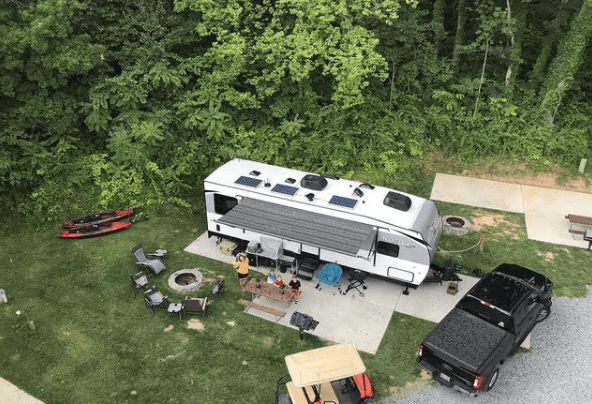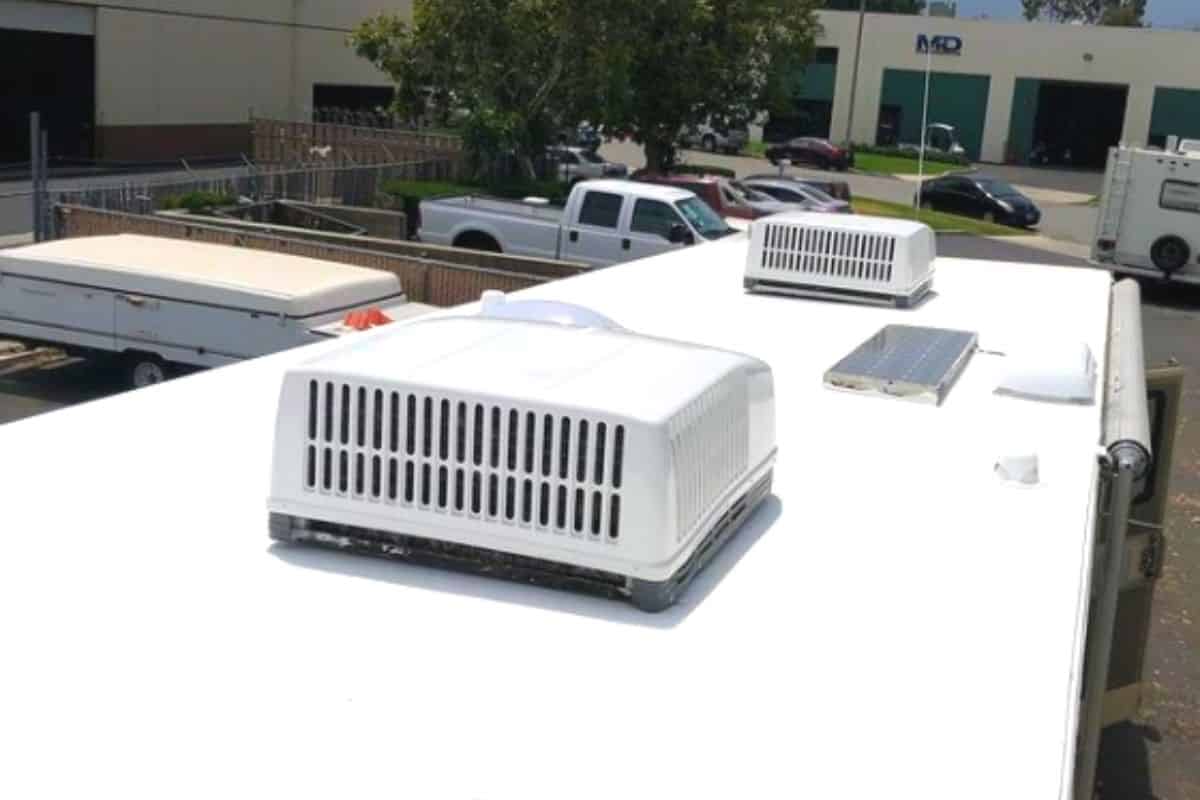There are many different types of RV roof materials on the market today, including rubber roofs, fiberglass roofs, vinyl roofs, and aluminum roofs.
However, the most popular type of RV roof material by far is the rubber roof.
But why is this and why do RVs have rubber roofs?
Most RVs have rubber roofs because of their many advantages, including lower cost, lighter weight, nonslip characteristics, excellent weather resilience, and less expensive repairs. The two main types of RV rubber roofs on the market today are the EPDM roof and the TPO roof.
There is so much more you need to know about your RV rubber roof though than just some of its advantages.
So if you want to learn how to tell what type of rubber roof you have, how to properly maintain a rubber roof, how long a rubber roof lasts, as well as how much it costs to replace one keep reading.
Do All RVs Have Rubber Roofs?
While the most popular type of RV roof is a rubber roof, not all RV roofs are made from rubber. In fact, there are several other types of roofs commonly used in the RV industry including fiberglass, aluminum, and vinyl.
With all the unique advantages of the rubber roof though you might be wondering why an RV manufacturer might choose another type of roof?
To begin with, rubber roofs do have some disadvantages.
Rubber Roof Disadvantages
- A rubber roof is not the most eco-friendly roofing material, as it is a petroleum-based product. (EPDM rubber roofs are made from recycled materials though.)
- Sharp objects falling or scraping a rubber roof can easily damage it.
- Rubber roofing is usually not used on the top of RV slide-outs.
- Rubber roofs are louder compared to fiberglass roofs when it’s raining.
Another common reason an RV manufacturer might choose a different type of roof is due to design elements and the type of construction used on the RV.
For example, it would look pretty odd and ruin the whole aesthetic of an Airstream trailer if Airstream tried to use a rubber roof on their all-aluminum trailer.

@jaycorv
Types of RV Rubber Roofs
There are two main types of rubber roofs on RVs including EPDM which stands for ethylene propylene diene monomer and TPO which stands for thermoplastic polyolefin which is a type of synthetic rubber.
EPDM Rubber Roof
The industry standard for rubber roofs on RVs has been the EPDM roof due to several unique advantages including low cost (on average around .80 cents a square foot), ease of installation, as well as excellent durability.
However, there are some disadvantages to the EPDM RV roof, including its unsightly black color and extreme heat absorption due to the dark color of EPDM.
More modern EPDM roofing materials do come in lighter colors, however, such as white and tan as opposed to the standard black but these lighter EPDM colors do have a premium cost.
TPO Roof
TPO is the relative new kid on the block for RV rubber roofs, as it came on the market in the early 1990s as an alternative to PVC roofing materials.
Today however TPO has quickly become the most widely used rubber roof on RVs and is quickly becoming the industry standard.
The TPO roof offers several unique advantages including an affordable price, stylish white and tan colors, and ease of installation.
TPO does have one major drawback though, which is its lack of durability over time, as TPO roofs have been known to fail sooner when compared to other types of RV roofing materials.
In addition, TPO roofing does not do well with prolonged exposure to extreme heat, such as baking sun, which can cause the material to quickly degrade.
How to Tell if You Have a Rubber Roof
When trying to determine if you have a rubber roof, the best way to do so, is to visually inspect and touch the RV roof itself.
It’s easy to tell the difference between a fiberglass roof and a rubber roof because a fiberglass roof will have a solid and hard feel while a rubber roof will have a soft and pliable feel.
It’s also easy to visually see and feel the difference between a hard aluminum metal roof and a soft and pliable rubber roof.
Things get a little trickier though when trying to tell the difference between a rubber roof and a vinyl roof as both materials tend to be soft and malleable. The easiest way to tell though if you have a vinyl roof as opposed to a rubber one, is to try and pinch the roofing material, as a rubber roof will pinch up while a vinyl roof will not.
How to Tell What Kind of Rubber Roof You Have
As mentioned above there are two types of RV rubber roofing materials on the market today including EPDM and TPO.
But how can you tell an EPDM roof from a TPO roof since they are both similar rubber-like materials?
Well, luckily there are several different ways to determine what type of rubber roof you have.
- Consult your owner’s manual as it will usually state the type of rubber roof you have.
- EPDM roofs tend to be slippery when wet while TPO roofs are not.
- TPO roofs tend to have a bumpy feel while EPDM roofs are very smooth.
- TPO tends to have a glossy look while EPDM roofs have a more flat or matte look.
- If you have an older EPDM roof it tends to develop a chalky look over time.
And if you still can’t determine the type of rubber roof you have, there is one sure-fire way to know but it is a little more involved and invasive as you will see in this short YouTube video.
Average Life Expectancy of an RV Rubber Roof?
A rubber roof will usually last anywhere from 10 to 12 years but can last for more than 20 years if the roof is well cared for.
Maintaining a Rubber Roof
- Keep the roof clean and free of debris. If you want to keep your rubber roof in tip-top shape and looking good, you should clean your rubber roof every few months. Make sure to not use any abrasive, citric, or petroleum distillate cleaners though as they can damage your rubber roof. We recommend Murphy Oil Soap (which you can find on Amazon by clicking here) when cleaning your RV rubber roof as it is a good all-purpose non-abrasive cleaner.
- Don’t park or store your RV under trees. Trees can drop leaves on your rubber roof which can cause mold and mildew to form faster. Trees can also drop sap on your rubber roof which can be very difficult to clean off.
- Use an RV cover when you store your RV. One of the best things you can do for your rubber roof as well as your trailer is to cover your RV with a breathable RV cover (like this one on Amazon). As an RV cover will keep the sun and weather off your roof, helping to prolong the life of the rubber roof exponentially.
- Inspect the rubber roof on a regular basis. When inspecting the rubber roof, be on the lookout for tears or punctures that might have compromised the roof and need repair.
- Inspect all caulking and seams on a regular basis. One of the most common failure points of an RV rubber roof is the caulking around vent pipes, vents, ac units, and where the roof and sidewalls come together. So make sure to inspect these areas on a regular basis and add additional caulking if the existing caulking has gaps or has been compromised.
How Much Does it Cost to Replace a Rubber Roof on an RV?
Even though a rubber roof is one of the cheaper options when it comes to RV roofs. There is nothing cheap about replacing an RV roof, as you can expect to pay around $300 a linear foot.
This means for a 30-foot motorhome, for example, it will cost around $9,000 to replace the rubber roof if the work is being performed by an RV dealer or repair shop.
The main reason why it’s so expensive to replace a rubber roof on an RV is due to the high labor cost of replacing the roof.
As replacing a rubber roof on an RV is very labor-intensive, requiring at least an hour of labor per linear foot. And with RV dealers and repair shops charging well over $100 per hour, you can see how the bill can add up quickly.
Can You Walk on a Rubber Roof?
Yes, RV rubber roofs are meant to handle light foot traffic to handle routine maintenance and inspection.
However, it’s important to remember that you are walking on a rubber membrane that can be damaged or punctured, so keep the foot traffic to a minimum and make sure you don’t have anything sharp stuck in the treads of your shoes that might damage or puncture the rubber membrane.
Also, it’s important to remember that rubber roofs can be very slippery, especially when wet, so make sure to always exercise extreme caution when walking on a rubber RV roof.
Recent Posts
When cruising down the highway in your RV, the last thing you want is a tire blowout! Not only is it dangerous, but RV tire replacement isn't cheap, costing $200 to $300 per tire. The good news,...
Nothing ruins an RV adventure faster than a breakdown with no way to fix it. Because of this, every RVer should have a well-stocked RV tool kit for those unexpected roadside emergencies and campsite...

